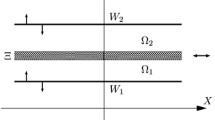Abstract
The motion of a viscous incompressible fluid under the action of electrical forces is studied in the framework of the physical assumptions of E.H.D. A theorem of the existence of weak solutions is given using the Faedo-Galerkin method. A result of uniqueness is also presented.
Similar content being viewed by others
References
Melcher JR, Taylor GI (1969) Electrohydrodynamics: a review of the role of interfacial shear stresses. Ann Rev Fluid Mech 1:189–201
Stratton JA (1941) Electromagnetic Theory. McGraw-Hill, New York
Temam R (1984) Navier-Stokes Equations. North-Holland, Amsterdam
Turnbull RJ (1964) Electroconvective instability with a stabilizing temperature gradient, II: experimental results. Phys Fluids 11:2597–2603
Author information
Authors and Affiliations
Additional information
Communicated by D. Kinderlehrer
Rights and permissions
About this article
Cite this article
Cimatti, G. Fluid motion in electrohydrodynamics driven by temperature gradients. Appl Math Optim 32, 99–107 (1995). https://doi.org/10.1007/BF01189905
Accepted:
Issue Date:
DOI: https://doi.org/10.1007/BF01189905



